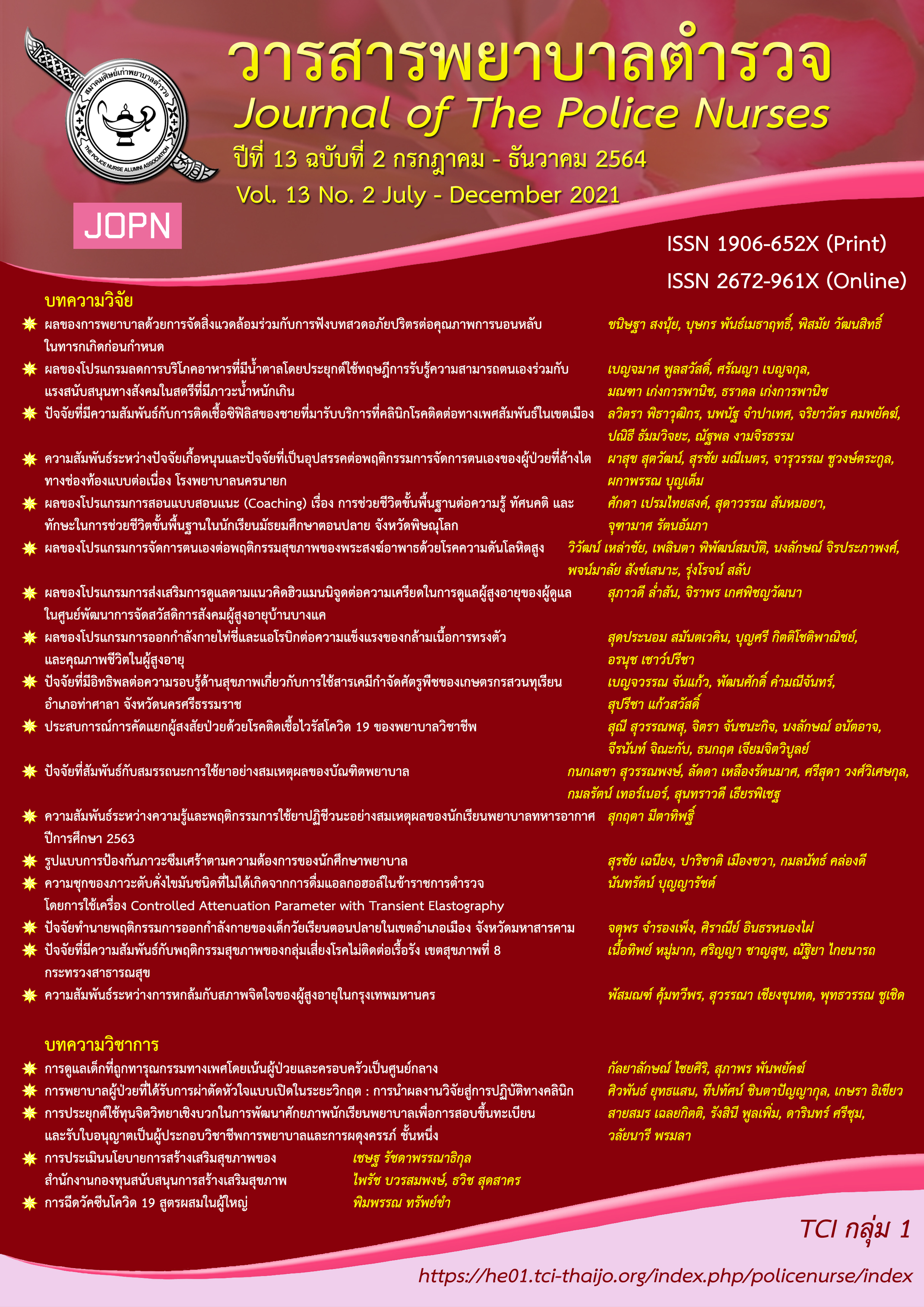FACTORS ASSOCIATED WITH SYPHILIS INFECTION AMONG MALE CLIENTS ATTENDING SEXAULLY TRANSMITTED INFECTION CLINIC IN URBAN AREA
Keywords:
syphilis infection, sexual behaviorAbstract
This research aimed to study factors related to men with syphilis infection from an urban STDs prevention center. This research was a case-control study divided into 112 infected people as the case group and 148 non-infected people as the control group from the Bangrak STI center and the Rainbow Sky Association of Thailand. Both clinics are large STD service providers in an urban area. The studied factors were personal factors and sexual behaviors. The instrument used in this research was a questionnaire about personal data and sexual behavior, which had content validity index (CVI) = 1, and the result of chemiluminescence immunoassay (CIA)/Treponema pallidum hemagglutination assay (TPHA). The data were analyzed using percentage, mean, standard deviation, Odds Ratio (OR), and 95% Confident interval (95%CI).
The findings revealed that factors related to men with syphilis infection consisted of 1) people with HIV-positive status were able to develop syphilis infection five times greater than people with HIV-negative status. (OR = 5.26, 95%CI = 1.432 - 19.347, p = .012), 2) people who had used drugs during sex for a year were able to develop syphilis two times greater than people who do not use drugs during sex. (OR = 2.878, 95%CI = 1.120 - 7.390, p = .041), 3) homosexual people were able to develop syphilis infection five times greater than heterosexual people (OR = 2.844, 95%CI = 1.372 - 5.948, p = .005), and 4) rarely or never using a condom during anal sex were able to develop syphilis infections twenty times when compared to having anal sex with a condom regularly (OR = 20.706, 95%CI = 8.401 - 51.035, p = .000).
HIV status is an important factor that can develop the syphilis infection. Moreover, various cases of syphilis infection can be found from the homosexual group and unprotected anal sex. Therefore, related agencies for both HIV and STDs should strive to promote and educate men who have unsafe sexual behaviors to know the importance and protect themselves from HIV and syphilis infection frequently.
Downloads
References
Banong-le, M., Ofosu, S. K., & Anto, F. (2019). Factors associated with syphilis Infection: A cross-sectional survey among outpatients in Asikuma Odoben Brakwa District, Ghana. BMC Infectious Diseases, 19(1), 1-9.
da Motta, L. R., Sperhacke, R. D., Adami, A. G., Kato, S. K., Vanni, A. C., Paganella, M. P., & Benzaken, A. S. (2018). Syphilis prevalence and risk factors among young men presenting to the Brazilian army in 2016: Results from a national survey. Medicine, 97(47), 1-7.
Dean, A. G., Sullivan, K. M., & Soe, M. M. (2013). OpenEpi: Open source epidemiologic statistics for public health, version. Retrieved from http://www.openepi.com/Menu/OE_Menu.html
Gomes, N. C., Meier, D. A., Pieri, F. M., Alves, E., Albanese, S. P., Lentine, E. C., & Dessunti, E. M. (2017). Prevalence and factors associated with syphilis in a reference center. Revista da Sociedade Brasileira de Medicine Tropical, 50(1), 27-34.
KhongkrirkKiat, N., Kittiyaowamarn, R, & Daengsaard, E. (2015). Sexually transmitted diseases 2015. Bangkok: Aksorn Graphic and Design.
Klakthongkorn, S., Yeong, A. P. A., & Yuttatri, P. (2016). Factors influencing sexual risk behaviors among youth with amphetamine use. Nursing Science Journal of Thailand, 34(2), 40-52.
Liao, M., Jiang, Z., Zhang, X., Kang, D., Bi, Z., Liu, X., . . . Jia, Y. (2011). Syphilis and methamphetamine use among female sex workers in Shandong province, China. Sexually Transmitted Diseases, 38(1), 57-62. https://doi.org/10.1097/OLQ.0b013e3181ebb475
Luo, Y., Zhu, C., Chen, S., Geng, Q., Fu, R., Li, X., Ding, J. (2015). Risk factors for HIV and syphilis infection among male sex workers who have sex with men: A cross-sectional study in Hangzhou, China, 2011. BMJ Open, 5(4), 1-8. https://doi.org/10.1136/bmjopen-2014-006791
Mutagoma, M., Remera, E., Sebuhoro, D., Kanters, S., Riedel, D. J., & Nsanzimana, S. (2016). The prevalence of syphilis infection and its associated factors in the general population of Rwanda: A national household-based survey. Journal of Sexually Transmitted Disease, 1-8. https://doi.org/10.1155/2016/4980417
Ratanalertnavee, J. & Rasmi, A. (2019). Prevalence and risk factors of HIV infection among migrant workers with syphilis and sexually transmitted diseases risk behavior: A case study of Takua Pa district, Phang Nga province. Region 11 Medical Journal, 33(1), 45-58.
Rachakulla, H. K., Kodavalla, V., Rajkumar, H., Prasad, S. P. V., Kallam, S., Goswami, P., . . . Brahmam, G. N. V. (2011). Condom use and prevalence of syphilis and HIV among female sex workers in Andhra Pradesh, India–following a large-scale HIV prevention intervention. BMC Public Health, 11(6), 1-16.
Park, H., Konda, K. A., Roberts, C. P., Maguina, J. L., Leon, S. R., Clark, J. L., & Klausner, J. D. (2016). Risk factors associated with incident syphilis in a cohort of high-risk men in Peru. PLoS One, 11(9), 1-10. https://doi.org/10.1371/journal.pone.0162156
Pathela, P., Braunstein, S. L., Blank, S., Shepard, C., & Schillinger, J. A. (2015). The high risk of an HIV diagnosis following a diagnosis of syphilis: A population-level analysis of New York city men. Clinical Infectious Diseases, 61(2), 281-287. https://doi.org/10.1093/cid/civ289
Yingyong, T. (2019). Syphilis disease has returned. Department of Disease Control, Ministry of Public Health. Retrieved from https://ddc.moph.go.th/doe/news.php?news=7722&deptcode=doe
World Health Organization. (2018). Report on global sexually transmitted infection surveillance, 2018. Geneva: World Health Organization.
Downloads
Published
Versions
- 2022-06-07 (2)
- 2021-12-31 (1)
How to Cite
Issue
Section
License
Copyright (c) 2021 JOURNAL OF THE POLICE NURSES

This work is licensed under a Creative Commons Attribution-NonCommercial-NoDerivatives 4.0 International License.
ผลงานที่ได้ตีพิมพ์แล้วจะเป็นลิขสิทธิ์ของวารสารพยาบาลตำรวจ



